This is a photo by Elias Bonaros of a teneral (soft) Neotibicen linnei cicada and its exuvia (molted skin). It was taken in 2009, and knowing Elias, probably in New York or New Jersey.
Click the photo from a larger version:
This is a photo by Elias Bonaros of a teneral (soft) Neotibicen linnei cicada and its exuvia (molted skin). It was taken in 2009, and knowing Elias, probably in New York or New Jersey.
Click the photo from a larger version:

Occasionally similar cicada species mate and form hybrids. Neotibicen linnei aka Linne’s Cicada exists in most of New Jersey and Neotibicen winnemanna aka Eastern Scissors Grinder exists in central and south-western New Jersey. These two species are known to hybridize. The other day I heard a cicada and wasn’t quite sure what it was. The tone sounded like Linne’s Cicada but the rhythm was like the Eastern Scissors Grinder. Is it a hybrid? The good people over on the Cicada Discussion, Science and Study Group say it’s likely a hybrid.
Here’s the audio:
Maybe the most interesting thing is proof of the existence of Eastern Scissors Grinder in Middlesex County, New Jersey. Others have heard them in East Brunswick as well.
Spectrogram:

Or listen on YouTube:
I was hiking the trails on Pyramid Mountain in Boonton, NJ on August 9th, 2022, when I came across a Neotibicen linnei (Smith and Grossbeck, 1907) aka Linne’s Cicada lying on the ground. Pyramid Mountain is geologically interesting and features glacial erratics of all shapes, sizes, and types (180-ton balancing boulders, purple pudding stones, green & black gneiss, green serpentinite, etc.), with plenty of rocks small enough to trip on and “roll an ankle”, so you have to keep your eyes on the trail. The cicada appeared dead, but it came to life once I picked it up. One of its forewings was too damaged to fly, though.
Dorsal view. It is a male. Note the green collar and two white pruinose spots on the sides of the abdomen.
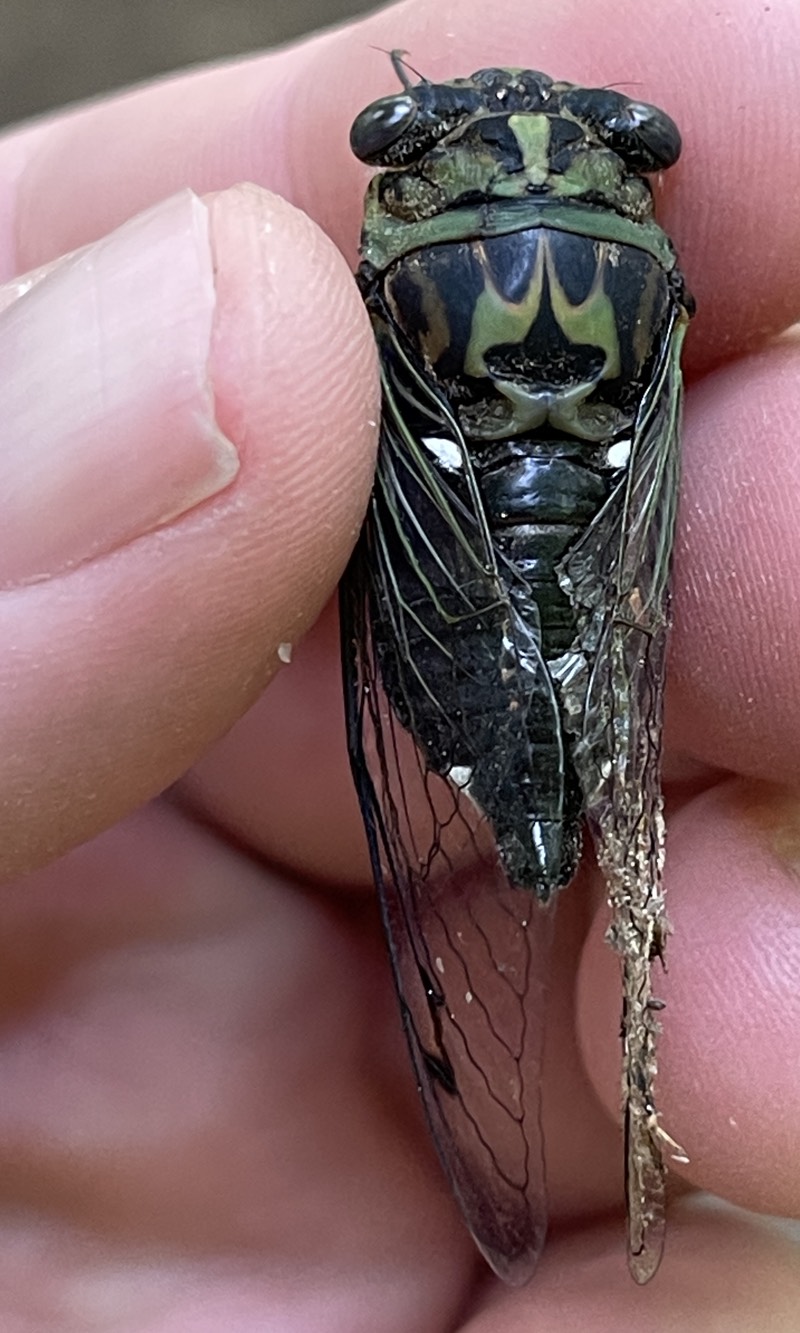
Ventral view. Note the overlapping opercula and clearly defined white pruinose on both sides of the abdomen.
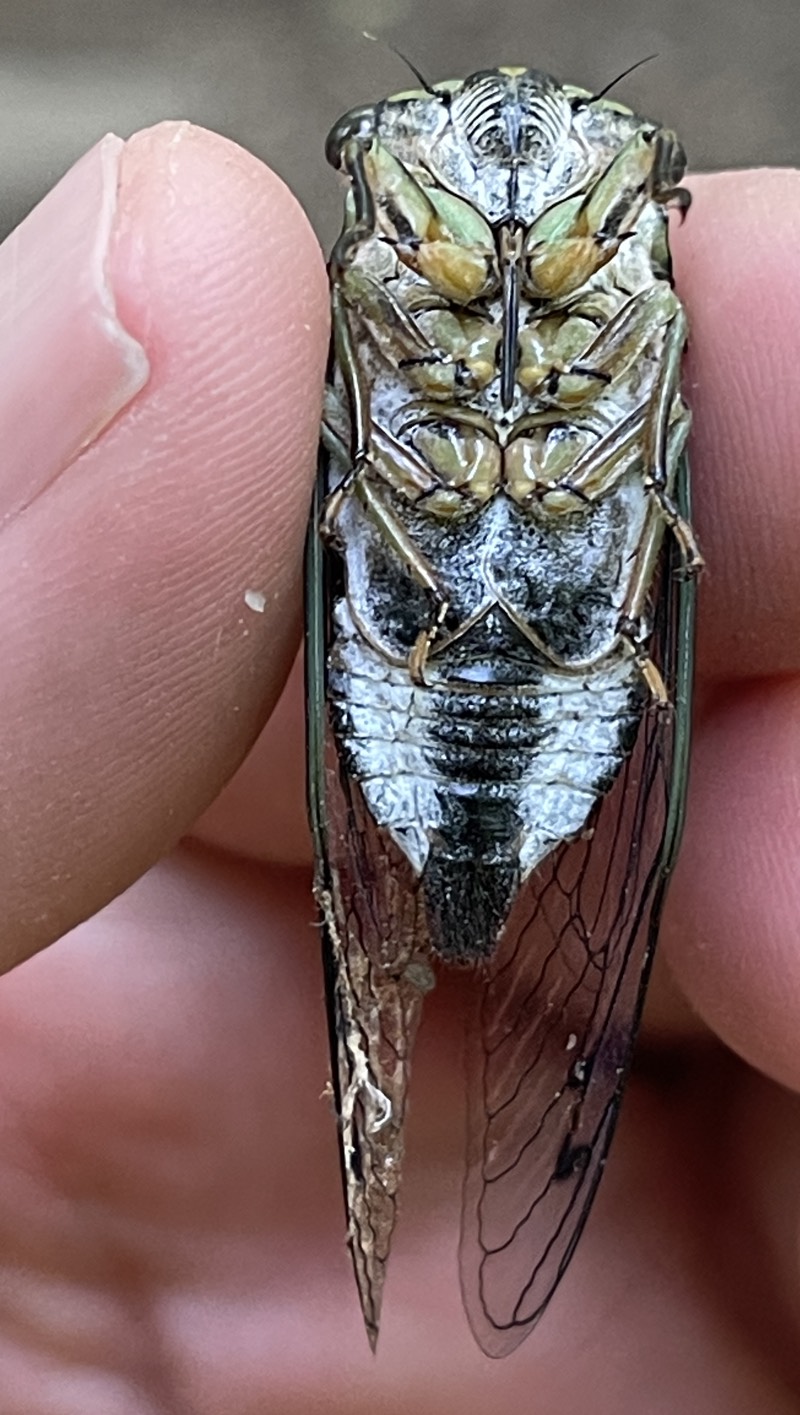
One forewing was damaged, torn, and dirty. It could not fly.
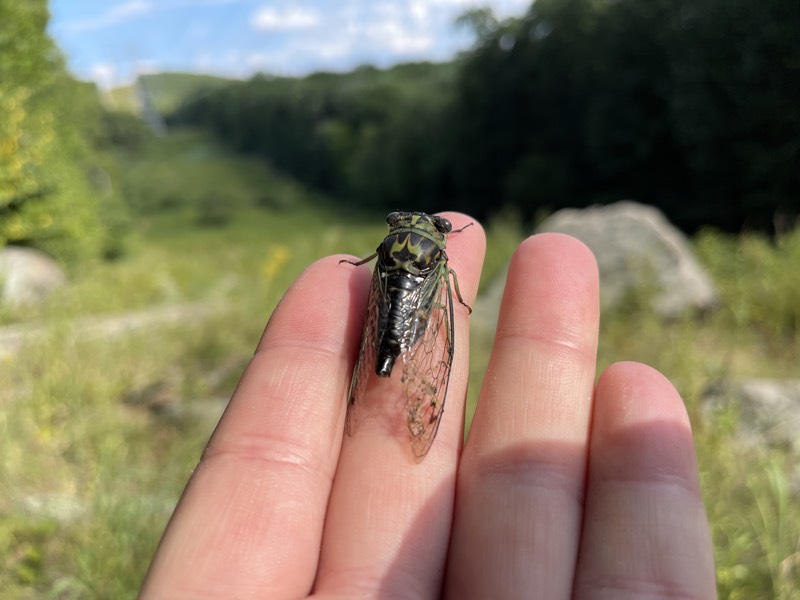
Davis provided a key of cicadas that belong to the then genus Tibicen in his 1918 article Mississippi Cicadas, with a Key to the Species of the Southeastern United States from volume 26 of the Journal of The New York Entomological Society. Download it from archive.org. This guide works for the Northeast and Midwest as well.
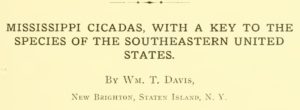
Since 1918, genus and some species names have changed, so I’m going to present the key here, with highlighted notes on the updated names + images (when I have them). I’ll try to replicate the formatting of the original document as best I can.
Here goes…
Note: the cicadas in the key are now organized in three genera: Neotibicen (A B), Megatibicen (A BB), and Diceroprocta (AA).
A. Large, heavy-bodied species; head broad, uncus [male genitals] simple, and first cross vein in the fore wings starting from radius 3 far back or about one-third distant from base of the first marginal cell.
B. Uncus longer than broad. Black species with green or greenish markings and black area on the central part of the abdomen beneath, except in sayi [sayi = Neotibicen tibicen tibicen], and new variety of davisi [new variety of davisi = Neotibicen davisi harnedi].
Note: this group of cicadas (B) are now organized under the genus Neotibicen, not Tibicen.
C. Hind margin of pronotum or collar, green or greenish.
A narrow irregular area of black on the under side of the abdomen; opercula short and broad, and usually in the males an attenuated, pruinose [frosty white] stripe each side on the dorsum of segment three … pruinosa (Say). [pruinosa = Neotibicen pruinosus pruinosus].
Dorsum of abdomen with the hind margin of the segments more or less brown and generally but a trace of pruinose stripe each side on segment three … pruinosa var. winnemanna (Davis) [pruinosa var. winnemanna = Neotibicen winnemanna].
[Generally speaking, east of the Appalachian mountains, you’ll find Neotibicen winnemanna, and west, it’s Neotibicen pruinosus.]
Dorsum of abdomen shining black with a broad pruinose mark each side on segment three; blackened area on under side of abdomen more in the nature of an even stripe … pruinosa var latifasciata (Davis) [pruinosa var. latifasciata = Neotibicen latifasciatus].
A longitudinal band of black on the under side of the abdomen, the opercula more lobate, and the margin of the front wings suddenly bent near the middle … linnei (Smith & Grossbeck) [linnei = Neotibicen linnei].
A definite longitudinal band of black on the under side of the abdomen; head with the front rather prominent. Not a large species … canicularis (Harris) [canicularis = Neotibicen canicularis].
An irregular band of black on the under side of the abdomen, head rounded in front; a rather small species … davisi (Smith & Grossbeck) [davisi = Neotibicen davisi davisi].
Abdomen greenish centrally on under side, blackened area wanting, marginal cells of fore wings clouded … davisi var. harnedi new variety [davisi var. harnedi = Neotibicen davisi harnedi].
CC. Hind margin of pronotum or collar black or nearly so (except in sayi var. australis).
D. Central area of the abdomen beneath black.
Opercula long and with the legs usually somewhat chest- nut colored ; the uncus when seen in profile forked, resembling the open mouth of a snake … similaris (Smith & Grossbeck) [similaris = Neotibicen similaris similaris].
Opercula much shorter, more rounded, and the black area on the under side of the abdomen in the nature of an even stripe. Uncus not forked … lyricen (De Geer) [lyricen = Neotibicen lyricen lyricen].
Blacker than typical lyricen, lacking the considerable amount of fulvous markings on the pronotum and mesonotum. A fulvous somewhat anchor-shaped mark centrally on the pronotum … lyricen var. engelhardti (Davis) [lyricen var. engelhardti = Neotibicen lyricen engelhardti].
DD. Central area of the abdomen not black beneath, often pruinose, as well as the long opercula.
Collar black, often with a greenish spot each side near the outer angles. … sayi (Smith & Grossbeck) [sayi = Neotibicen tibicen tibicen].
Collar all green or nearly so, as well as the pronotum and mesonotum … sayi var. australis (Davis) [sayi = Neotibicen tibicen australis].
BB. The uncus is broad at the base, triangular in shape, and generally about as broad as long. Opercula broad and rounded at the extremities no definite black area on the central part of the abdomen beneath, usually unicolorus.
Note: this group of cicadas (BB) are now organized under the genus Megatibicen, not Tibicen.
E. Wings long and narrow, collar 2 mm. or less in breadth at central portions ; dorsum of abdomen black or nearly so.
Basal cell of fore wings rusty in color, anal cells (membranes) of both pair of wings gray; usually expands 110 mm. or more … resonans (Walker) [resonans = Megatibicen resonans].
Basal cell of fore wings often black or nearly so, anal cells of both pair of wings yellowish. Expands about 100 mm … figurata (Walker) [figurata = Megatibicen figuratus].
EE. Wings broad, hind margin of the pronotum or collar green or greenish and more than 2 mm. broad.
F. Anal cells or membranes at base of fore and hind wings gray.
Dorsal segments of the abdomen not margined with brown ; in fresh specimens the basal segments pruinose, also the terminal segments, leaving the four middle segments black. A large species expanding over 110 mm. … grossus (Fabricius) [grossus = Megatibicen grossus].
FF. Anal cells or membranes at base of fore and hind wings light orange, two prominent marks on the mesonotum resembling the Hebrew letter resh inverted.
Fore wings with the first and second cross veins clouded, and the dorsum of the abdomen brownish or brownish black … resh (Haldeman) [resh = Megatibicen resh].
Fore wings with the first and second cross veins but faintly or not at all clouded and the abdominal segments margined posteriorly with brown. In fresh specimens there is usually a median row of white spots on the dorsum of the abdomen … marginalis (Walker) [marginalis = Megatibicen pronotalis walkeri].
AA. Small species; wings starting from about the middle of the first marginal cell.
Note: this group of cicadas (AA) are now organized under the genus Diceroprocta, not Tibicen.
G. First and second cross veins of fore wings clouded.
Expanse of wings about 90 mm … biconica (Walker) [biconica = Diceroprocta biconica].
Expanse of wings about 60 mm … olympusa (Walker) [olympusa = Diceroprocta olympusa].
GG. First and second cross veins of fore wings not clouded, wings clear throughout and expanding about 70 mm.
Head rather large, front rounded, collar greenish or yellowish and contrasted in color rather sharply with the brown and black of pronotum and mesonotum … viridifascia (Walker) [viridifascia = Diceroprocta viridifascia].
Head proportionately smaller than in the last ; front more pro- truding;- collar not so contrastingly colored and fore wings narrower … vitripennis (Say) [vitripennis = Diceroprocta vitripennis].
and that’s all folks…
Neotibicen linnei (Smith and Grossbeck, 1907) aka Linne’s Cicada.
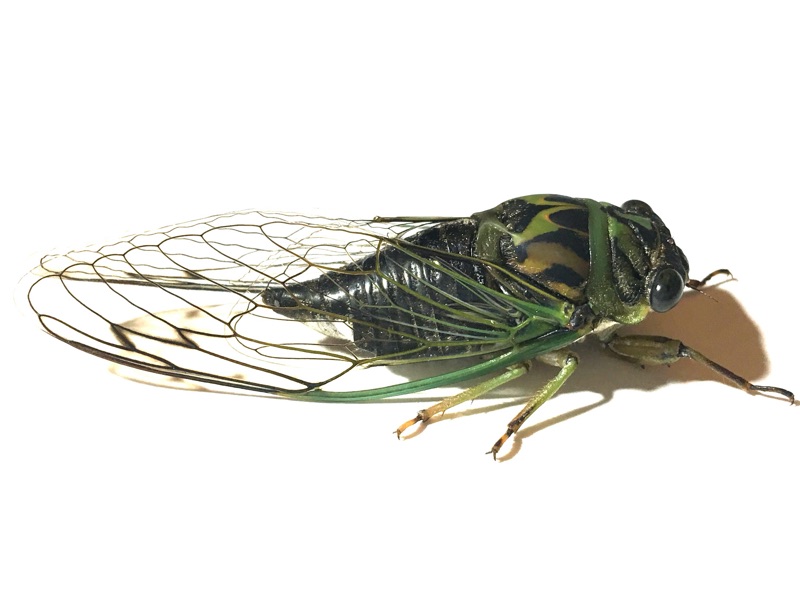
Photo by Dan Mozgai.
See all Neotibicen linnei images & information about cicadamania.com.
Source: ©Insect Singers
Playlists contain multiple videos found on YouTube.
The female of this species often closely resembles that of T. pruinosa [Neotibicen pruinosus], but in linnei the fore wings are abruptly bent near the middle, whereas in pruinosa the curve is more regular. The song is very different from that of pruinosa and is a continuous z-ing, but generally of short duration.
A. Large, heavy bodied species ; head broad, uncus simple, and first cross vein in the fore wings starting from radius 3 far back, or about one third distant from base of first marginal cell.
B. Uncus longer than broad. Black species with green or greenish markings and black area on the central part of the abdomen beneath
C. Hind margin of pronotum or collar, green or greenish.
A longitudinal band of black on the under side of the abdomen, the opercula more lobate, and the margin of the front wings suddenly bent near the middle.
Example of the wing bend:
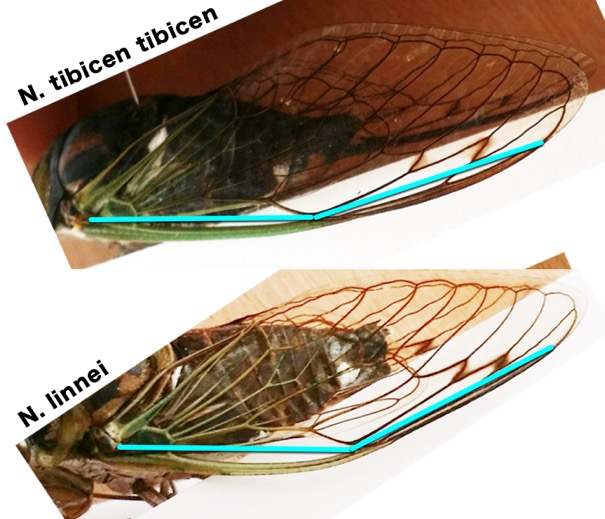
Color varies, even from the same location:
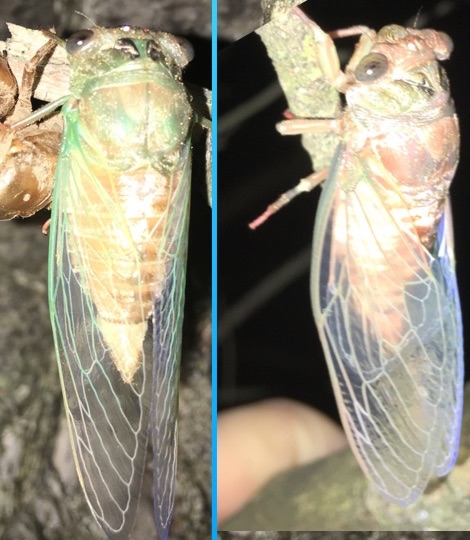
Family: Cicadidae
Subfamily: Cicadinae
Tribe: Cryptotympanini
Subtribe: Cryptotympanina
Genus: Neotibicen
Species: Neotibicen linnei (Smith & Grossbeck, 1907)
A single photograph of a female Neotibicen linnei aka Linne’s Cicada from Monmouth county NJ. 2017.

Two Teneral Neotibicen photos by Roy Troutman. Teneral means soft. These cicadas have recently molted so their bodies are soft. The photos were taken in 2004, probably in Ohio.
This one looks like a Neotibicen tibicen tibicen:
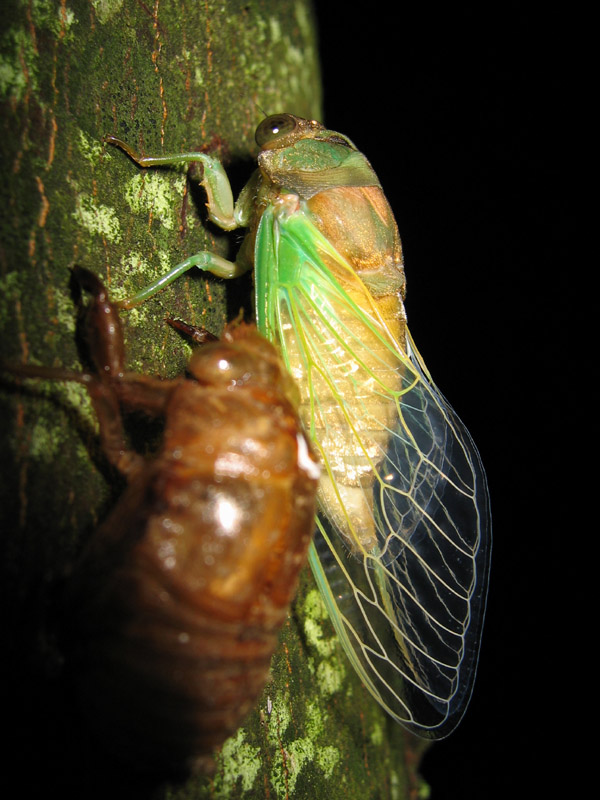
This one looks like a Neotibicen linnei or pruinosus.
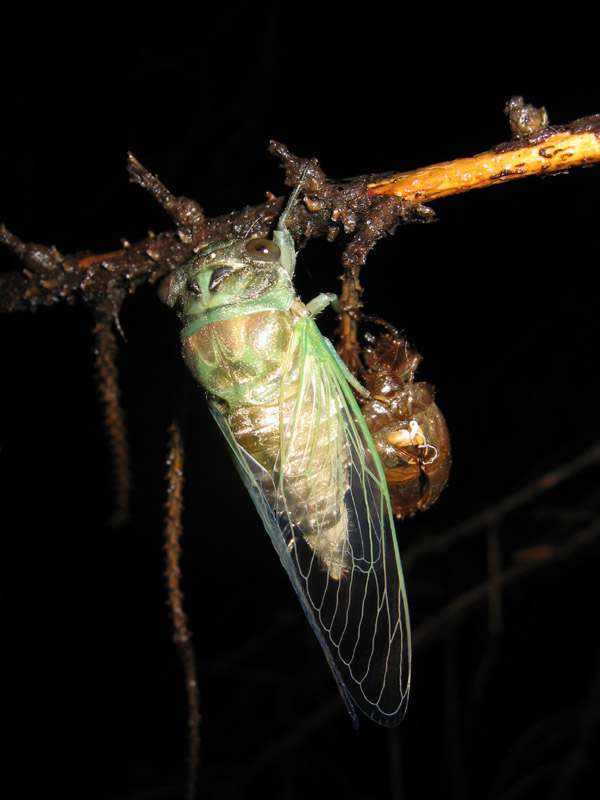
A Neotibicen linnei (Linne’s Cicada) photo by Roy Troutman from 2004. Probably taken in Ohio.
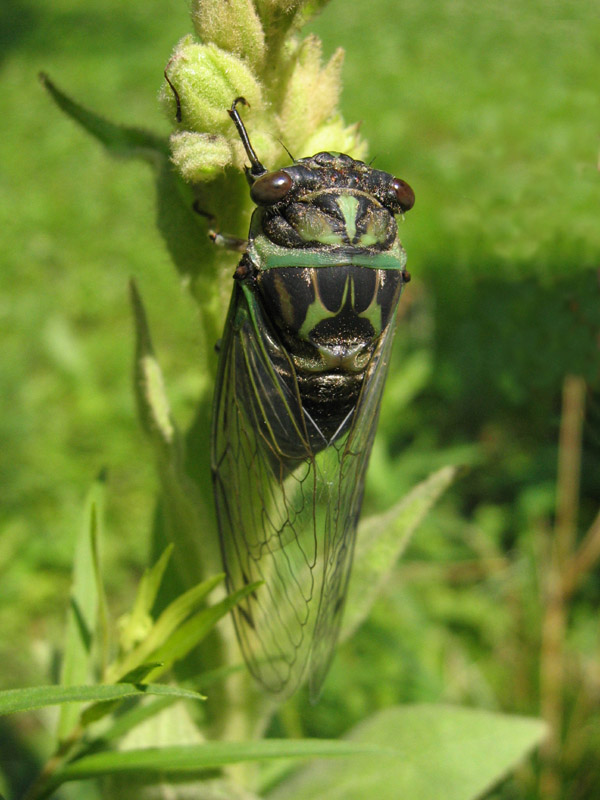
Tom Lehmkuhl sent us this photo of an uninvited house guest, a Neotibicen linnei cicada.
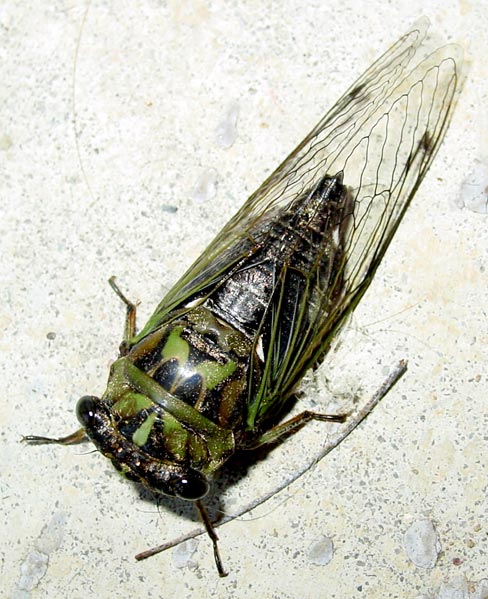
Nighttime is often the best time to find cicadas.
Nymphs, generally speaking, emerge soon after sunset. When I look for nymphs, I wait until sunset and start looking around tree roots and on tree trunks. Sometimes it takes hours, but usually, I find one (or many).
Cicada Nymph:
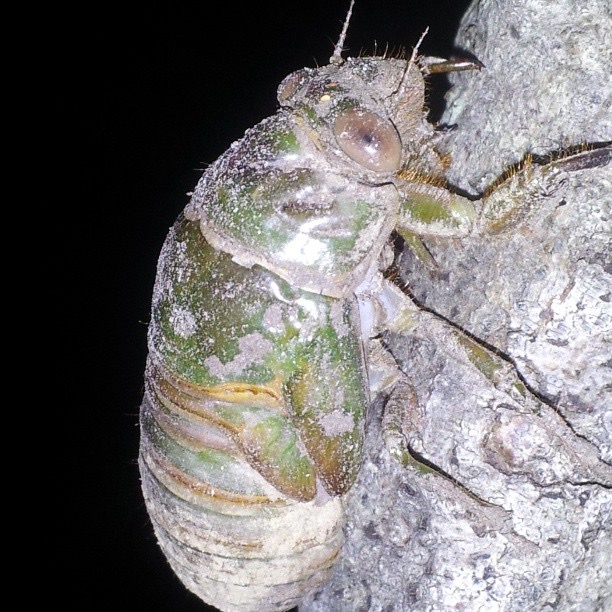
Adult cicadas are easiest to find on hot, humid nights in well-lit areas like parking lots and the sides of buildings. You will find them clinging to illuminated walls and crawling on sidewalks. They end up on the ground, often because they fly into the wall and stun themselves. On a hot humid night — 85F or above — I’ll find an excuse (usually frozen desserts) to check the walls of the local supermarket for cicadas.
Cicadas, like many insects, are attracted to (or confused by) lights. There are many theories as to why insects are attracted to lights, and the reasons why probably vary by species. My guess (and this is just a guess) is that cicadas can’t tell day from night, or daylight (sun) from artificial lights, and so they think they’re using light to navigate away from a dark area (a tree trunk, dense brush), and then get very confused because they never seem to get anywhere once they reach the source of the light. I wish I could ask a cicada why.
Prime nighttime cicada location: a well-lit building and macadam parking lot:

Cicadas can damage their skin and innards by fling into and bouncing off walls:
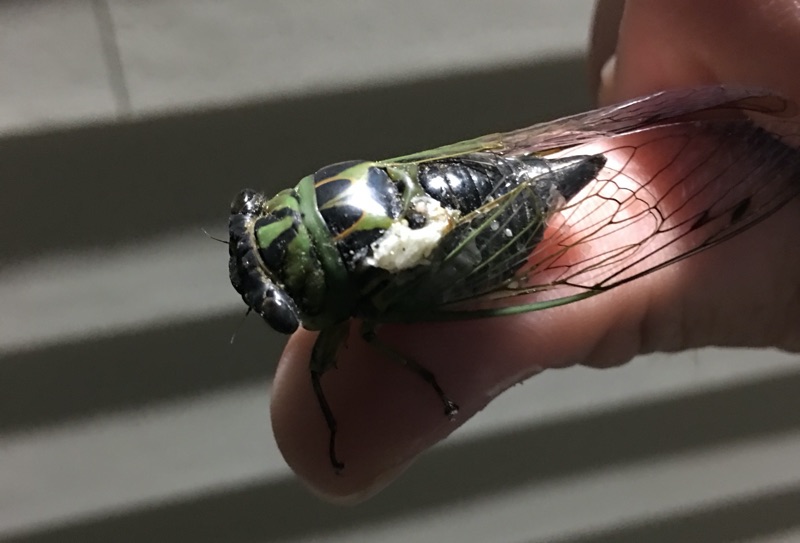
A Neotibicen tibicen clinging to a cinderblock wall:
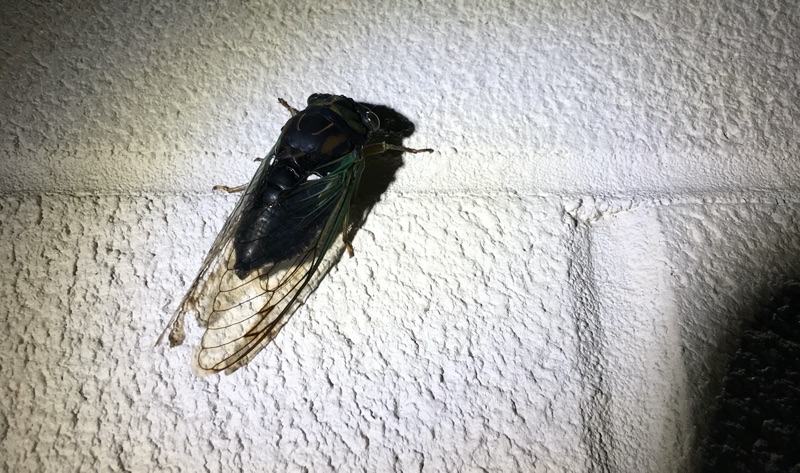
A Megatibicen auletes crawling on an illuminated sidewalk:
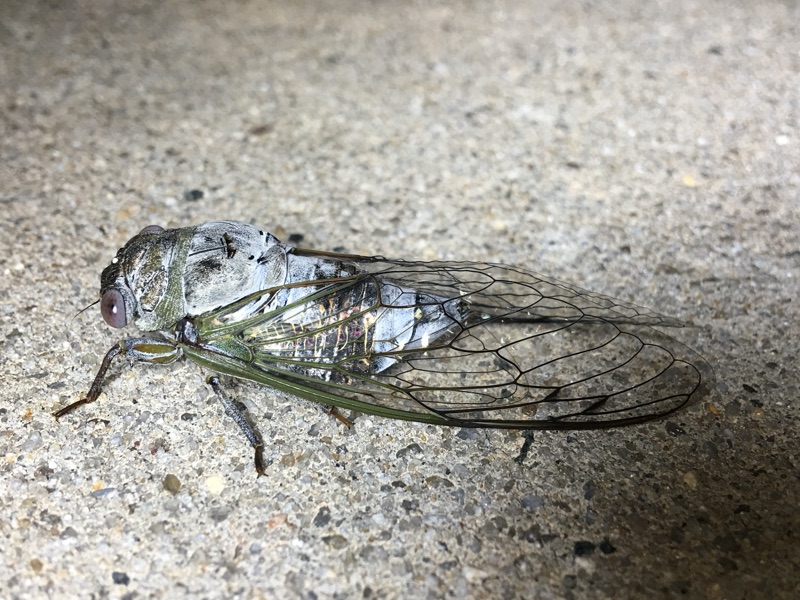
If you go looking for cicadas at night, make sure you have permission to be where you plan to look. Don’t trespass, and have respect for other people’s property.